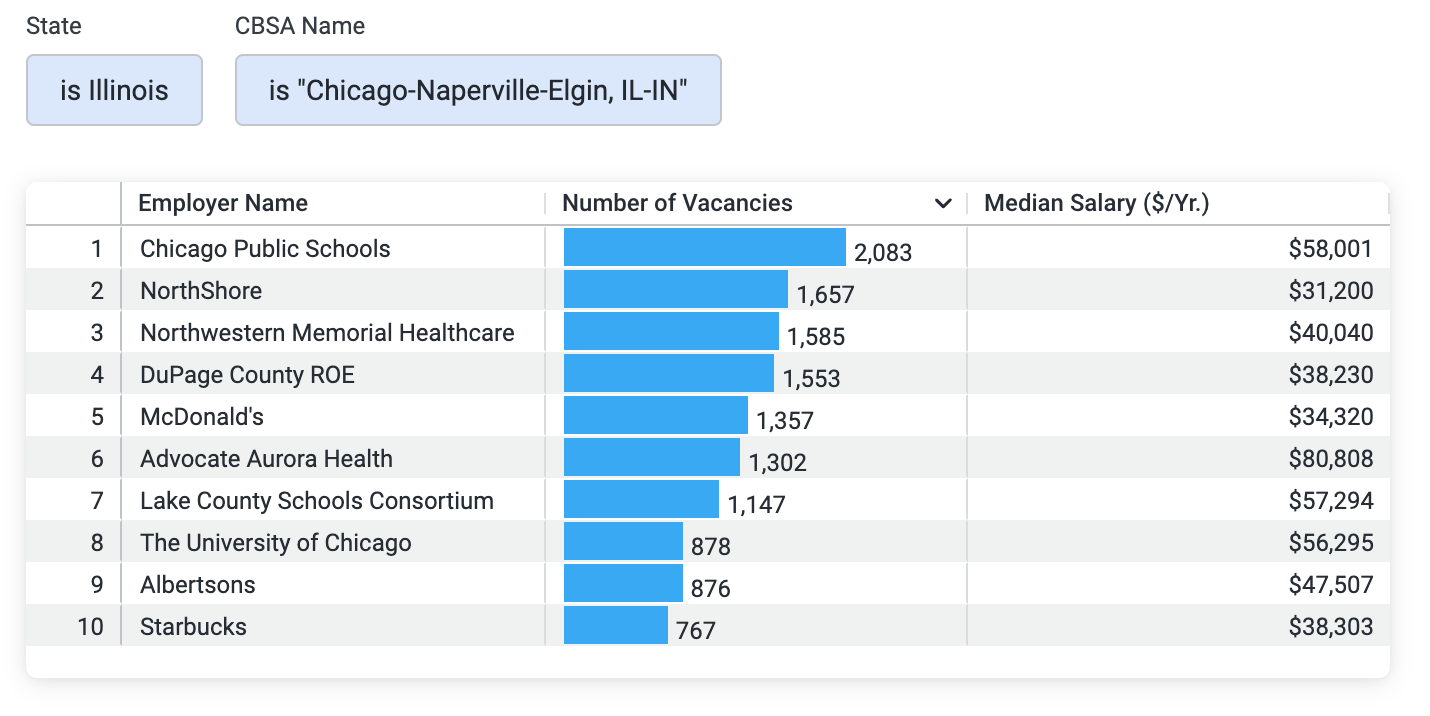
What Is Talent Competition?
Recruiters working in the same industry and location are often competing against each other for the same talent. But they’re competing with more employers than those in just the same area or industry. Talent competition extends beyond that.

Figure 1: Our definition of “talent competition”
You might have a talent competitor because they offer a low barrier to entry and comparable wages. In this case, Abercombie & Fitch could compete with Taco Bell. The two are in different industries, but their part-time positions require minimal training and offer similar pay.
(Notably, talent competition decreases as roles become more specialized.)
This is all to say: the only way to out-recruit your talent competition is to first identify who they are. Keep reading for five ways you can do that with real-time jobs data.
Talent Competition Identifier #1: Industry
In-house and contracted recruiters know the first place to look for talent competitors is an employer’s own industry. It’s why so many sales executives in the tech space bounce from Zendesk to HubSpot to Salesforce. These companies all advertise competing products, and they require similar knowledge from their sales teams.
But talent competitors may also exist in adjacent industries. For example, a senior living recruiter might want to check out the broader healthcare space when hiring RNs and CNAs. In-house hiring teams and recruiters can complete this research with the help of real-time jobs data.
💡User Tip 💡Job Market Pulse breaks down every available listing by industry. Use this to your advantage. Filter employers by industry. Create custom “industry” reports that track vacancies over time. Forecast market trends by comparing job posting habits across similar industries.
Industry is just one factor you should use to find talent competitors, though. Other factors will bring employers from various industries under your “talent competition” umbrella.
Talent Competition Identifier #2: On-the-Job Training
Plenty of roles don’t have formal educational requirements. Instead, they require mandatory certifications that are available via on-the-job training (e.g., ServSafe certifications in restaurants and fall protection safety on construction sites).
Candidates can join these companies without much (if any) related experience. That means they could realistically choose between working as bartenders, construction workers, or flight attendants. All these roles offer on-the-job training and don’t require anything beyond a high school diploma.
That’s why, if you want to hire and develop early-career workers, you’ll want to know which companies also offer on-the-job training that advances those workers’ careers. That knowledge comes from real-time jobs data.
💡User Tip 💡You can use the keyword “on-the-job training” to search for roles, but you can also search for specific certifications (e.g., “PMP certification”) in Job Market Pulse. This helps broaden the scope of your talent competition research.
Talent Competition Identifier #3: Location
While remote work has remained popular, more than 95 percent of jobs require at least some onsite attendance. This means location is still a top consideration when it comes to finding talent.
💡User Tip 💡If your work with, or for, an employer that has multiple offices across the country, or operates remotely, you can select different metro markets in Job Market Pulse and compare them to each other. This can help you fill roles more quickly. For example, if there’s a lot of talent competition in, say, California, for software engineers, you may decide to recruit and staff engineers in your Illinois office instead of California.

Figure 2: Despite varying widely by industry, the top 10 employers, by number of vacancies, in the Chicagoland area can be talent competition.
You may see this list of nearby employers and think to yourself: “Some of these companies are completely unrelated to the one I work with.” That might be true. But this information is still valuable and important to track.
Here’s why: let’s say you’re recruiting for Northwestern Memorial Healthcare and one of the companies in the area is Starbucks (Figure 2). Northwestern Memorial might not be competing with Starbucks for full-time talent, but they could be competing for student workers who might otherwise join the Northwestern Memorial internship program.
Talent Competition Identifier #4: Available Roles
Want to know if an employer is a talent competitor? See whether they’re hiring for the same roles. A simple keyword search for a title like “software engineers” will let you see which employers are currently hiring for that role.
💡User Tip 💡When searching roles on Job Market Pulse, remember that you can see positions that are synonymous with each other. For example, when searching for “business development representative,” you’ll also see listings for “sales representatives” or “market development representatives.”
Recruiters and hiring teams can also use historical jobs data to gain a clearer picture of possible talent competition. If an employer isn’t currently hiring for the same roles you’re recruiting, that doesn’t mean they aren’t a talent competitor. This employer might have hired for those roles three months earlier. Find out with historical jobs data.
Talent Competition Identifier #5: Compensation Package
Hiring teams can identify talent competitors by checking the wages that employers advertise in job listings. If, for example, the company you work with plans to pay a retail associate $15 per hour, you can use jobs data to see which employers offer similar, higher or even lower compensation.
Reminder: this wage research will yield more talent competitors across no- / low-experience positions and those that provide on-the-job training.
Relatedly, when reviewing this wage data, consider the relationship between complexity and compensation of the role. The RN wages at senior living communities may be lower than those at healthcare providers, but working hours may be more predictable. This gives senior living hiring teams a clear angle they can use to recruit RNs: better work-life balance.
Wages aren’t the only component of compensation packages, though. Benefits should also factor into your talent competition search. An employer might offer lower compensation than you, but they could augment it with comprehensive health coverage and a generous PTO policy.
When you search for benefits, you can discover other talent competitors that you might have overlooked.
💡User Tip 💡Job Market Pulse lets you filter positions by listed wage. But it also lets you filter roles by, for instance, sign-on bonuses, via keyword search. Search that phrase and see what comes up.
Real-Time Jobs Data Is One Piece of Your Recruitment Strategy
Real-time jobs data is the best way to identify which employers are talent competitors. But data can only get you so far. There are other aspects of the employee experience you need to consider when recruiting talent.
For instance, consider the mission of a business. Studies show that employees will accept lower pay to work at a mission-driven company. Company missions may not come through in job listings, but they do inform whom you might consider talent competition. A company with an altruistic mission and lower pay could compete with a company that offers higher pay but less of a mission.
The takeaway here: the more informed you are, the more strategic your recruitment strategy can become.
Interested in hearing more about how real-time jobs data can help you stand out from the talent competition? See what Job Market Pulse looks like in action!